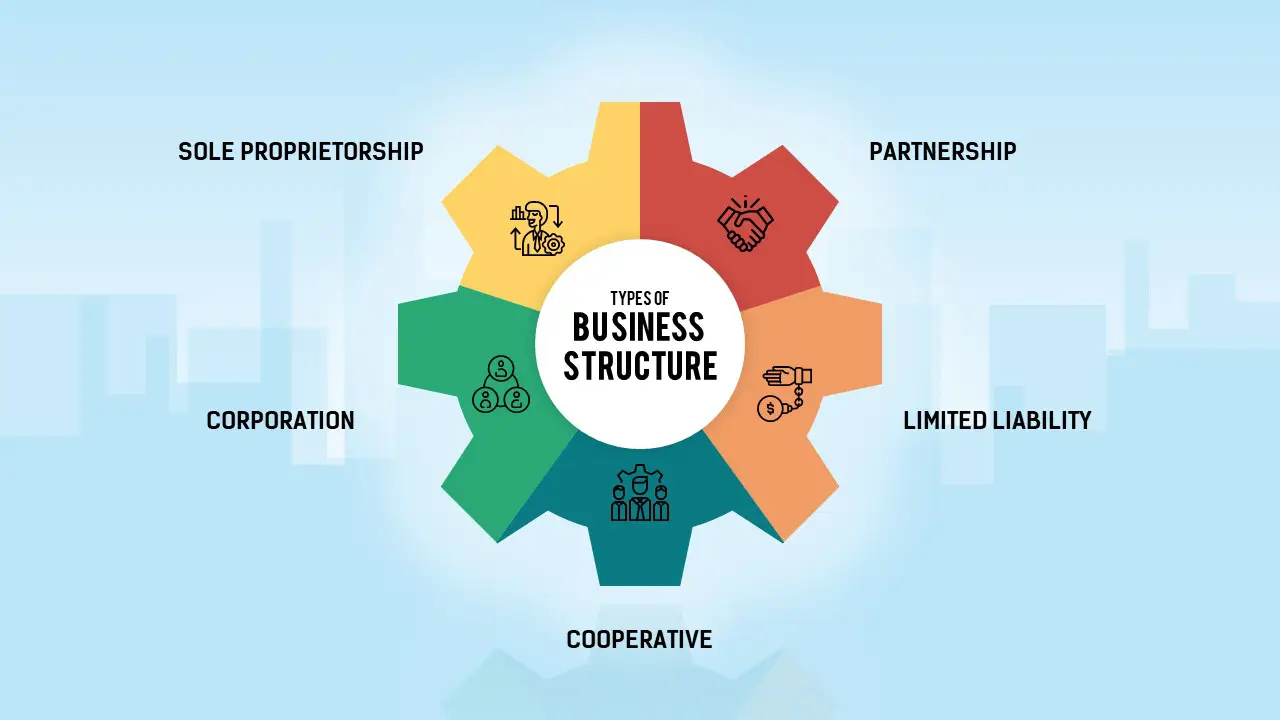Which Business Structure is Right for You?

When you going to start a business, have to make clear what type of organizational structure that you going to choose. There are five main types of business structures; sole proprietorship, partnership, limited liability, cooperative and corporation. Each configuration has different tax, income and liability implications for businesses proprietors and their companies. The type of business structure varies from country to country. The reason behind the structural change relies on the socio-cultural peculiarities and the existing legal system of the particular country. However, the modern context and the global business culture create a specified business structure in all countries. In this post, we are revealing the specialities of each business types with its benefits.
You should pick a business structure that gives you the right balance of legal protections and benefits. Your business structure affects how much you pay in taxes, your capability to generate money, the correspondence you need to file, and your personal liability.
You’ll essential to select a business structure before you register your business with the government. Most businesses will also need to get a tax ID number and documents for the proper licenses and permits.
Select sensibly. While you may adapt to a diverse business structure in the future, there may be limitations based on your location. This could also result in tax penalties and accidental dissolution, among other complications.
Common business structures

templates designed by slidebazaar.com
Sole proprietorship
Sole proprietorship is the simplest statutory structure available for businesses. According to the Internal Revenue Service (IRS), it is the most common form of business in almost all countries. Businesses structured as a sole proprietorship lets the proprietors have total control over company operations. Businesses that typically form sole proprietorships are a shop or retail businesses, home-based businesses and one-person consulting firms. Holders of sole proprietor businesses are accountable for their own bookkeeping and paying the IRS in the form of self-employment taxes. Though, this type of business provides no protection for business owners, as they can be held personally liable for their company’s debt and financial debts. This type of business structure can also be hard to generate money because you can’t sell the stock, and lenders are hesitant to give money to sole proprietorships.
Sole proprietorships can be a good selection for low-risk businesses and owners who want to trial their business idea before materializing a more formal business.
Partnership
A partnership is shaped when two or more people join, or partner, together to run a business. Each partner has the same share in the net profits and losses of their business. Comparable to a sole proprietor, each partner reports their revenue on their personal tax return and pays self-employment taxes to the IRS. They are also individually responsible for financial debt and obligations of their company and also the activities of other partners. Though partnerships can be created through verbal agreements and handshakes, written agreements can be the best option in the event of arguments or lawsuits between partners. When an entrepreneur has an idea but he/she doesn’t have that much money to start a business, forming partnership will be the best option. There are 2 types of partnerships: limited partnerships (LP) and limited liability partnerships (LLP).
Limited partnerships have only one common partner with limitless liability, and all other partners have limited liability. The partners with limited liability also tend to have limited control over the company, which is acknowledged in a partnership agreement. Profits are distributed through to personal tax returns, and the sole partner — the partner without limited liability — must also pay self-employment duties and taxes
Limited liability partnerships are the same as a limited partnership, but give limited liability to every owner. An LLP shields each partner from debts against the partnership; they won’t be answerable for the actions of other partners.
Limited liability Company
This is one of the newest forms of business structure. The limited liability structure is considered a fusion as limited liability companies can be fashioned as corporations or partnerships. LLCs can provide proprietors, who are commonly referred to members under this configuration, the protection from liability and other responsibilities similar to a corporation. Limited liability companies are a set up like a partnership or corporation. . The taxation of LLCs is also subject to on its structure. Members of a Limited liability company are considered as self-employed and must pay self-employment tax donations towards Medicare and Social Security. Due to its limited protection, some businesses such as banks and insurance companies are restricted from being LLCs.

LLCs can be the best choice for medium- or high-risk businesses, owners with significant private assets they want to be protected, and owners who want to pay a lower tax rate than they would with a corporation.
Corporation
A corporation, occasionally called a C corp, is a legal entity that’s separate from its owners. Corporations can make a profit, be taxed, and can be held legitimately liable. Corporations offer durable protection to its proprietors from personal obligation, but the cost to form a corporation is higher than other configurations. Corporations also need more broad record-keeping, operational processes, and reporting. Unlike sole owners, partnerships, and LLCs, corporations pay income tax on their profits. In some cases, corporate profits are taxed two times — first, when the company makes a profit, and again when surpluses are paid to investors on their personal tax returns.
The most composite organizational structure for businesses is the corporation. This type of business structure divides the liabilities and obligations incurred by company operations from being the responsibility of the owners. Corporations are controlled by the laws of the government they are set up in. Unlike sole proprietor and partnership businesses, corporations are taxed as separate entities at corporate tax rates. The IRS taxes corporation proprietors at individual tax rates. Two types of corporate structures are: Subchapter C and S. The difference between the two subchapters originate from different tax rules. Ordinary corporations are measured by Subchapter C corporations. Subchapter S corporations, unlike Subchapter C companies, can pass income and losses onto their stockholders to avoid paying central income taxes. This prevents double taxation of corporate profits.
Cooperative
A cooperative is a business or organization possessed by and operated for the benefit of those using its services. Profits and earnings made by the cooperative are distributed among the membership holders, also known as user-owners. Naturally, an elected board of directors and officers run the cooperative while regular members have voting power to control the direction of the cooperative. Members can become part of the cooperative by purchasing shares, though the quantity of shares they hold does not affect the weight of their vote.
If you are looking to start a new venture, choose your business structure that suits your visions and objectives in respect to your capacities with a mind of bearing risks and losses. When picking a business structure, be sure to choose the one that gives the most benefits and is the best structure for small ventures.


